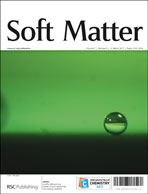Characterization and modelling of a dense lamella formed during self-compression of fibrillar collagen gels: implications for biomimetic scaffolds
Abstract
The three dimensional microstructure and fluid conductivity of hydrogels are major determinants of their physical and mechanical properties. Under free fluid flow conditions, highly hydrated fibrillar collagen gels expel fluid and undergo a gravity driven consolidation process (self-compression). Within minutes of the initiation of self-compression, collagen scaffolds with fibrillar densities resembling those of native tissues are produced. However, the microstructural and mechanical processes responsible for collagen gel consolidation have not been fully investigated. During self-compression of collagen gels, a thin, high density lamella of collagen forms at the fluid expulsion boundary thereby generating a two-layer structure. By applying Darcy's law to model fluid flow in the two-layer structure, a novel method was developed to measure the hydraulic permeability of hydrated collagen gels as a function of gel mass loss. Experimentally measured permeability values of the lamella ranged from 4.3 × 10−15 to 1.2 × 10−14 m2 which were 100 to 1000-fold less than those of the hydrated collagen layer. These


 Please wait while we load your content...
Please wait while we load your content...